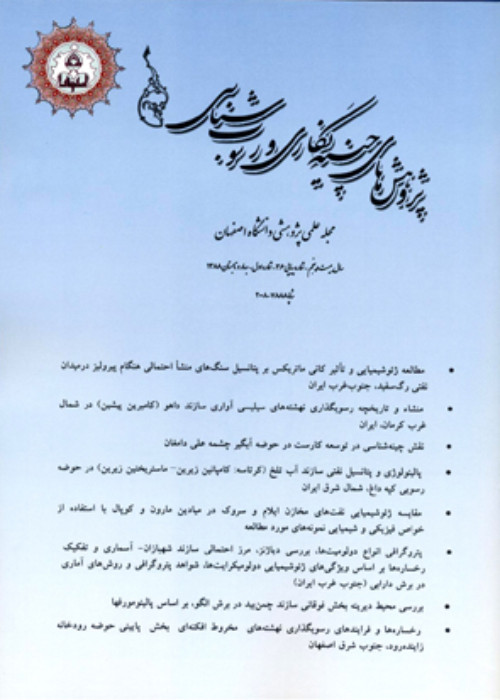Evaluation of Pabdeh/Asmari boundary based on calcareous nannofossil biostratigraphy at north eastern limb of Gurpi anticline, Khuzestan Province
Author(s):
Article Type:
Research/Original Article (دارای رتبه معتبر)
Abstract:
Introduction
One of the most extensive Tertiary deposits is the marine strata of Pabdeh and Asmari Formations in Zagros, which was studied based on paleontology studies. Type section of Pabdeh Formation is located in Tang-e Pabdeh, North of Lali oilfield and type section of Asmari Formation is located in Tang-e Gel-Torsh in Asmari Mountains (James & Wynd, 1965). One of the most important achievement obtained from Pabdeh and Asmari Formations is the evaluationof boundaryand biostratigraphy of it. In the north eastern limb of Gurpi anticline, boundarybetweenof Pabdeh and Asmari Formations consists of 290 m thick which mainly consists of marl, marly limestone and shale.Material &
Methods
In this study 64 samples from Pabdeh and Asmari interval have been studied. Samples were prepared following standard smear slide method (Bown and Young 1998). All slides were studied under polarized light microscope at ×1000 magnification. The nomenclature of calcareous nannofossil follows the taxonomic schemes of Perch-Nielsen (1985) and Fornaciari et al. (2010).Discussion of Results &
Conclusion
In order to study biostratigraphy based on calcareous nannofossils, boundary of the Pabdeh/Asmari in north eastern limb of Gurpi anticline, Emamzadeh Baba section was selected. In this section, Pabdeh Formation with 235m thickness is mainly consists of shale, marly limestones, marl and Asmari Formation with 55m thickness is consists of limestones. For introducing index species, calcareous nannofossil assemblages and biozones, slides have been studied at the Pabdeh/Asmari Formations interval which led to the recognition of 39 species and 18 genera of calcareous nannofossils. In this study four biozones were detected in Pabdeh/Asmari boundary. Biozones Sphenolithus pseudoradians Zone(NP20), Ericsonia subdisticha zone (NP21), Helicosphaera reticulata Zone (NP22) and Sphenolithus predistintus Zone (NP23) in Pabdeh Formation with Priabonian-Rupelian in age and Sphenolithus distentus Zone (NP24) in Asmari Formation with Rupelian- Chattian of Martini (1971) zonation, equivalent to biozones (CNE19 - CNO5) of Agnini et al. (2014) zonation and (CP15b- CP19a) of Okada and Bukry (1980) zonation. According to the first and last occurrence of index species the following bio zones are identified:Sphenolithus pseudoradians zone(NP20/CP15b)This biozone is recorded from the FOSphenolithus pseudoradians to the LO of Discoaster saipanensis. The age of this zone is Late Eocene (Priabonian). The thickness of this zone has been measured approximately 71.4 m.
Ericsonia subdisticha zone (NP21)
The second zone is recorded from the LO of Discoaster saipanensis to the LO of Ericsonia formosa. The age of this zone is Late Eocene- Early Oligocene (Priabonian/ Rupelian). The thickness of this zone is 73 m.
Helicosphaera reticulata zone (NP22/ CP16c)
This zone spans the interval from the LO of Ericsonia formosa to the last occurrence of Reticulofenestra umbilica. The age of this zone is Early Oligocene (Rupelian). The thickness of this zone is 25 m.
Sphenolithus predistentus zone(NP23/ CP17-18)
The next nannofossil unit recorded in this study is theNP23. This zone spans the interval from the LO ofReticulofenestra umbilica to the FO ofSphenolithus ciperoensis. The age of this zone is Early Oligocene (Rupelian). The thickness of this zone was measured about 85 m.
Sphenolithus distentus zone (NP24 / CP19a)
The last biozone recorded is NP24. This zone is from the lower part of Asmari Formation.This zone spans the interval from the FO of Sphenolithus ciperoensisto the LO ofSphenolithus distentus. The age of this zone is Late Oligocene (Chattian). The thickness of this zone was measured about 34 m.
So, as result of this study and according to the identified biozones, the age of Pabdeh/Asmari boundary is Late Eocene (Priabonian) to Late Oligocene (Chattian).
Keywords:
Language:
Persian
Published:
Stratigraphy and Sedimentology Researches, Volume:34 Issue: 1, 2018
Pages:
19 to 30
magiran.com/p1856976
دانلود و مطالعه متن این مقاله با یکی از روشهای زیر امکان پذیر است:
اشتراک شخصی
با عضویت و پرداخت آنلاین حق اشتراک یکساله به مبلغ 1,390,000ريال میتوانید 70 عنوان مطلب دانلود کنید!
اشتراک سازمانی
به کتابخانه دانشگاه یا محل کار خود پیشنهاد کنید تا اشتراک سازمانی این پایگاه را برای دسترسی نامحدود همه کاربران به متن مطالب تهیه نمایند!
توجه!
- حق عضویت دریافتی صرف حمایت از نشریات عضو و نگهداری، تکمیل و توسعه مگیران میشود.
- پرداخت حق اشتراک و دانلود مقالات اجازه بازنشر آن در سایر رسانههای چاپی و دیجیتال را به کاربر نمیدهد.
In order to view content subscription is required
Personal subscription
Subscribe magiran.com for 70 € euros via PayPal and download 70 articles during a year.
Organization subscription
Please contact us to subscribe your university or library for unlimited access!


